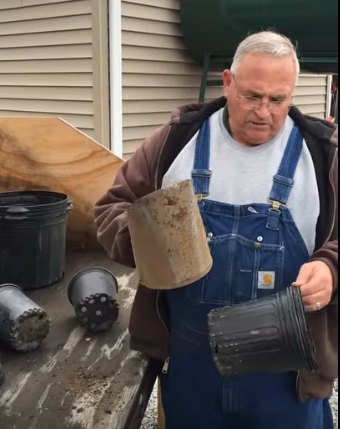This question comes up a lot in Our Members Area because a lot of members, including myself, recycle used nursery pots. Why? Because it’s crazy not to! These plastic nursery containers have no business in our landfills if small backyard growers like us can recycle them, make good use of them, and keep them out of the landfills.

Separating “stuck” used nursery containers (pots) the easy way.
Sorry about the video orientation, me and Cathy, a couple of rookies first time doing video with an I-phone. But . . . we can bring you more valuable content if we focus on getting things done instead of making them perfect. To be perfectly honest, I just don’t have time to go back and re-shoot a video that’s not perfect.
People ask, how should I sterilize used nursery containers before I use them?
I’ll tell you what I do, not what you should do. You decide.
Most nursery containers are black. When the sun hits them they heat up. I mean they really heat up, especially when empty. That heat dries them out completely. Fungi, insect and other things you need be concerned about need moisture in order to remain viable. There is no moisture in a stack of nursery pots sitting outside in the summer time.
That’s all the sterilization that my pots get. Plants are tough, they are resilient, they don’t need coddling! For years and years me and lots of other nursery folk that I know simply re-use the pot. If we had to rinse them in bleach or something it would be easier and cheaper to throw them away.
That’s how it happens in the real world. On the Internet it’s more like; “Oh my! I wouldn’t even think about re-using a nursery container without first sterilizing it. Why is that? Because on the Internet you are getting information from folks who have never worked in the trade. They just don’t know what happens in the real world.
Me? I’ve spent my entire adult life crawling around in the dirt on my hands and knees. The only things that I can share with you are things that actually happen in the real world.
Watch the movie to see how easy it is to separate used nursery containers that are stuck together. It works. Trust me it works.
Questions, comments, mean things to say? Post them below and I’ll respond.
Mike: I have a nursery and make a market in used pots in Western Oregon. The greenhouse liner growers have to sterilize because of the greenhouse humidity and the tens of thousands of plants in close proximity. They mostly use steam or hot water baths. Most other growers do not sterilize. If they have a disease problem they do not reuse the pots.
I find it faster to separate pots by inserting a pot hold down stake (1/4″ wire rod, 24″ long, with a curve on the end) in the drain holes of a bottom pot, stepping on the stake, and gently pulling up on the upper pot. Beats beating it with a piece of pipe or other methods we have tried.
Carl,
Thanks for the tip, getting them apart can be challenging at times.
I love watching a professional in action! Great info as always!
Bleach tends to degrade many plastics, so the pots might not hold up well after being soaked in a bleach solution. Soaking in a strong vinegar solution might be a good option,and/ or a quick scrub with a stiff brush dipped in white vinegar, since almost no organisms won’t survive the extreme acidity – but the vinegar will not harm the pots.
Vinegar will also help remove crusty deposits from ceramic and clay pots.
http://www.suddenoakdeath.org/wp-content/uploads/2015/02/P.tentaculata.Pest_.Alert_.022315.pdf
There is a very interesting story surrounding this disease, and how people spread it in their own plants and to natural areas by re-using pots. I agree that heating up pots (solarization) can be a great sterilization technique in some situations. But you ARE taking on some risk when using dirty pots!
Ruth,
If you are in an area where Sudden Oak Death is present you might be required to treat your pots.
Thanks Mike, Makes sense about the black plastic pots in the sun. Unfortunately I don’t have much sun time in my backyard.
Also, what about lighter colored plastic pots, white, tan, green, ….and porous clay pots. Should we sterilize them in a bleach solution. I have a handy garden/wheelbarrow type garden cart that would be perfect.
Hank,
All I can say is that I would not. When you really think about it, what could be in the pot that is not already in the soil and environment. Plants are like people, they have an immune system that works better than people give them credit for.
Great Info…